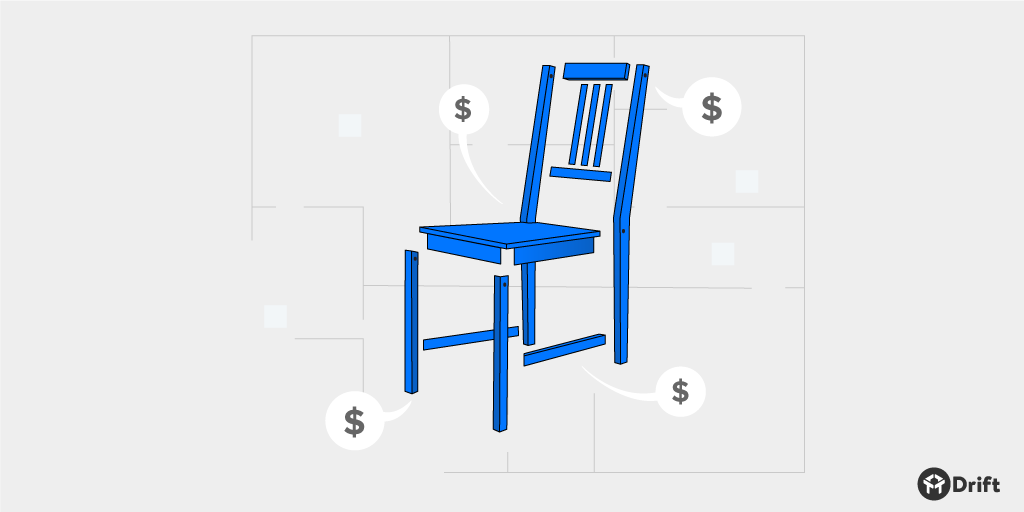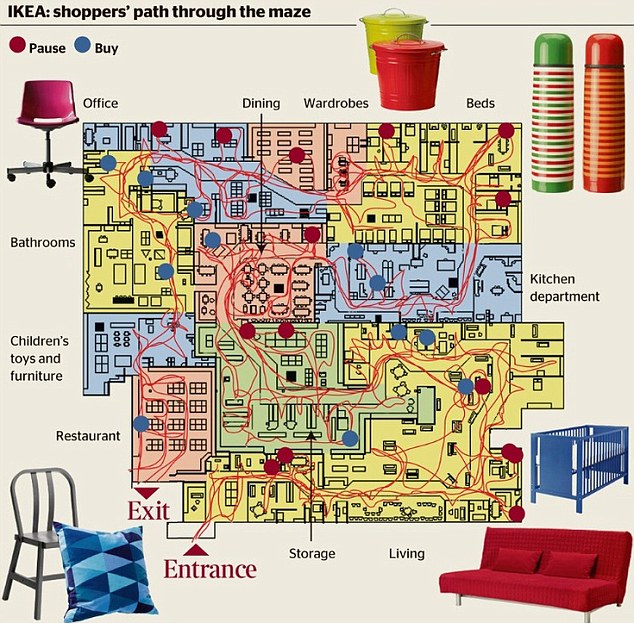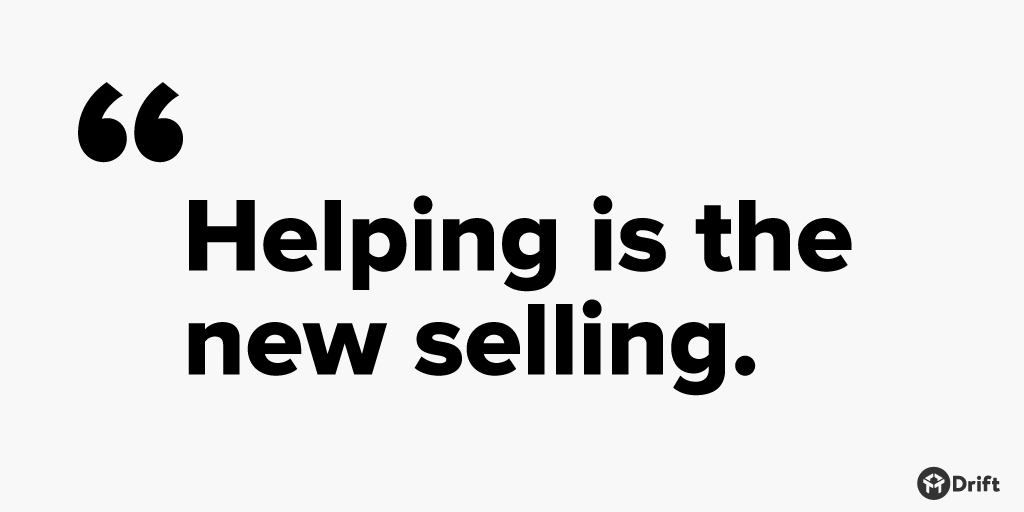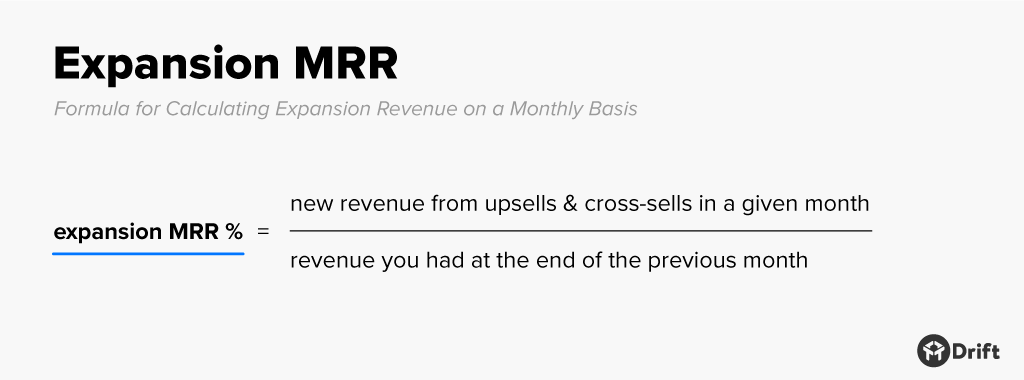
If you’ve ever been shopping at Ikea, you know that it’s not your typical trip to the store…
It’s an experience.
Because Ikea is more than just a store: it’s a showroom, self-service warehouse, and Swedish meatball dispensary all rolled into one.
When you walk in, you’re completely immersed in Ikea’s world. Living rooms, kitchens, dining rooms, bedrooms.
The last time I was there, it was to pick out a kitchen table and some chairs. I’m pretty sure that by the end of it, I had sat in every single chair they had — the Henriksdal, the Ingolf, the Börje, you name it.
And, at my wife’s request, I had even carried chairs around the showroom to see how they’d fit at different tables.
Ikea is the ultimate example of a company that lets you “try it before you buy it.” But they really do more than simply let you sample their products.
As I mentioned above, Ikea provides an immersive experience. And it’s an experience that’s pretty much unrivaled in the world of furniture stores … unless you’re from New England, of course, where Jordan’s Furniture stores have IMAX theaters, rope courses, and other attractions.
But with 391 locations in 48 countries (compared to Jordan’s 7 locations in 5 states), and annual revenue in excess of $35 billion, Ikea is the world’s leading furniture retail chain.
Ikea also happens to be the 46th most valuable brand in the world, ahead of such well-known brands as Sony, Chevrolet, Kellogg’s, Rolex, CVS, and Nestle.
So it’s safe to say that Ikea’s approach is paying off in a big way. But what might come as more of a surprise is that the model Ikea uses is a perfect fit for modern SaaS companies.
As our CEO David Cancel explained in a meeting recently:
Getting people to experience your product, to experience your brand, and to see what being a customer feels like before ever having to spend a dime — that’s the future of SaaS sales. And it’s a model Ikea has been using for years: Let people test out the product themselves and let them figure out if it’s a good fit. The role of sales shouldn’t be to force people into a purchase, it should be to help them every step of the way.
In other words, prospective customers need to be able to get into your product, for free, so they can move the proverbial furniture around.
Let them see how this feature of your product works alongside side that feature. Show them how they can integrate your product with this platform or that platform. Help them determine if your product can serve as a viable replacement for this service or that service.
To help you take full of advantage of this approach to SaaS sales — the Ikea approach — I’ve come up with three key principles you can follow.
1. Design the path your customers should take
A study out of the UK found that the average Ikea shopper spends more than 3 hours inside. And some shoppers spend as long as 8 hours inside.
This behavior doesn’t happen by accident. As a store design researcher once told the Daily Mail:
In Ikea’s case, you have to follow a set path past what is effectively their catalogue in physical form, with furniture placed in different settings which is meant to show you how adaptable it is.
Here’s what that “set path” looks like:

Of course, when it comes to a SaaS product, you definitely don’t want to design a maze. You don’t want your prospective customers to literally get lost.
You do, however, want your prospective customers to figuratively get lost in your product — you want them to immerse themselves in your product completely, to explore every nook and cranny, and to discover every feature and capability.
By the end of their journey along that set path you’ve created for them, your prospective customers should — ideally — be thinking about becoming paying customers.
In the world of SaaS, one of the most important elements of that set path is your free user onboarding flow.
As our designer Elyse Bogacz explained, there are 3 steps Drift recently took to make our onboarding flow more effective.
1. Reduce the time to WOW. You want people to get excited about your product from the get-go, so show them something cool early in the process. At Drift, we have people customize our live chat widget with their brand colors as one of the first steps.
2. Surface what’s important. What are the things your customers absolutely must get set up in order for them to have a great experience with your product? At Drift, we think it’s crucial that people add avatars and set up welcome messages in order for our live chat product to feel more personal … but for the longest time we weren’t actually telling people to do it in our onboarding flow. It was a simple change, but it’s made a huge difference.
3. Know who you’re talking to. Is the person going through your onboarding flow going to be able to make sense of the installation instructions? Is there code involved? At Drift, we now have two distinct installation options: A) do-it-yourself, where we walk you through the process of putting the code on your site step-by-step, and B) let someone else do it, where we provide a link for inviting a coworker to do it.
Ultimately, the experience a customer has during onboarding will play a role in how they feel overall about your product. So don’t gloss over it: Spend the time to design a path that people will enjoy and benefit from following.
2. Help customers help themselves
At Drift, we love talking to our customers, and we love making it easier for them to have 1:1 conversations with their customers.
But what we don’t love is bothering people, and getting in the way of people who want to explore our product independently.
Ever walk into a store and immediately get bombarded by an overzealous (and likely over-caffeinated) salesperson who asks you a million different questions and tells you about a million different discounts?
That’s definitely not the sales experience today’s SaaS buyers are gravitating toward.
And it isn’t the way Ikea does sales either.
Ikea’s employees don’t run around the showroom floor offering customers discounts and telling them about limited-time offers. And they don’t try to wrangle customers into buying their most expensive futons.
Instead, Ikea’s on-the-floor employees are simply there to help customers when they need help and to answer questions when they have questions.
Otherwise, if customers don’t need help, and if they don’t have any questions, they don’t get forced into unnecessary conversations. They’re free to shop as they please.
And when customers are ready to checkout, Ikea’s unique warehouse-and-showroom-in-one design means that they can pick out their desired products from the ground floor entirely on their own — no need to wait for an employee to get something from the stockroom. It’s all right there.
Ikea’s dedication to self-service has set it apart in the retail furniture space. And you can use the same approach to set your SaaS company apart.
If someone tries out your SaaS product, loves it, is ready to buy and doesn’t have any questions, they should be able to make the purchase without having to talk a salesperson first. Self-service checkout should be an option.
But if someone does have questions and does want to talk to a salesperson before they buy … great! That’s the whole point of having salespeople: They’re there to help.
As we say all the time here at Drift, helping is the new selling.

Of course, self-service checkout isn’t the only way you can help customers help themselves.
At Drift, for example, we use our intelligent routing chatbot, Driftbot, to bring a new level of self-service to customer support.
Since integrating Driftbot with our knowledge base, Driftbot can now automatically share links to help docs based on what people are asking us in live chat.
I still remember the first time I saw this thing kick into action. I was talking to a couple of customers when someone messaged in with a really simple question about the product. I think the question was “Do you integrate with Slack?”
So I was just about to respond “Yep!” and explain a bit more about it when BAM: Driftbot jumped in and shared a link to our help doc that explains the Slack integration.
The person on the other end of the chat ended up responding with something like, “Whoa! That was awesome. Nevermind, got my answer. Thanks!”
To clarify, the point of using Driftbot here isn’t to replace a human-to-human interaction, it’s to make it as easy as possible for our customers to get the information they need.
The self-service that Driftbot can provide is perfect for cases where customers are asking simple questions — where they’re asking questions you already know the answers to.
Customers benefit because they can avoid having unnecessary conversations, and they’re empowered to solve problems on their own.
You benefit because it lets you save your brain power for tackling the more complicated questions.
3. Don’t forget about the meatballs
Ikea is a furniture retailer. (I think we’ve thoroughly established that fact.)
But did you know that Ikea also serves 150 million meatballs to customers each year?
That’s a lot of freaking meatballs. So many, in fact, that last year revenue from Ikea’s food division outpaced revenue from its furniture division.
The takeaway here for SaaS companies:
Don’t forget about expansion revenue.

Upselling and cross-selling are crucial to the SaaS sales model. They help make up for churn and — ideally — they can help you achieve negative churn (i.e. when the gains from upsells/cross-sells outweigh the losses from churn).
The tricky part is figuring out what your company’s “meatballs” are going to be.
What features or functionality do you have that you can sell in addition to your primary product? How can you get your customers to grow with your product, to move from a lower tier to a higher tier?
One piece of advice for figuring this out: listen to what your customers are telling you.
Customer feedback can help you determine which product capabilities customers are comfortable paying extra for and which capabilities should always come standard with the core product.
A word of warning though: Pricing ain’t easy. And it’s probably better to think of it as an ongoing, ever-evolving process as opposed to something that you’re going to get 100% right in one shot.
As our CEO recently wrote in a post on SaaS pricing, “I’m sure our pricing will continue to change as we learn more and we become more educated.”
The most important thing to remember when it comes to SaaS pricing is to make sure you’re always aligning what (and who) you’re charging with the value people are receiving.
To quote our CEO once more,
Software is racing toward free. So you should really only charge those people who are actively using it and deriving value from it.
Final Thought
Never be afraid to look outside of your industry for inspiration and ideas.
Is the Ikea/SaaS sales analogy perfect? Of course not. But thinking about it does help us tap into something broader about how people like to buy these days — something we might miss if we only focused on what companies are doing in the SaaS world.
At the end of the day, all industries are serving the same customers: humans. So by studying companies that are renowned for providing amazing customer experiences, like Ikea, we’re bound to learn something useful.



